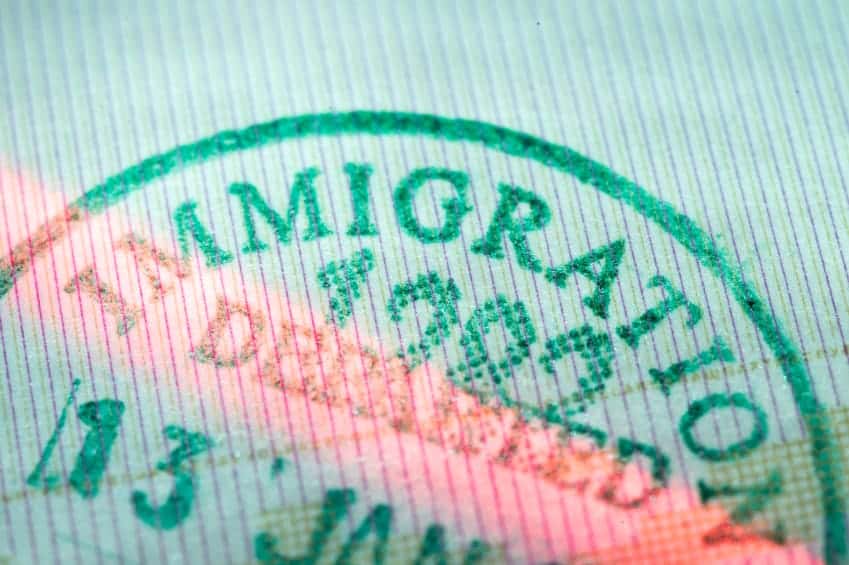What would mass deportation really look like for small and middle-sized employers?
The whole thing is fantasy, of course, much like apocalyptic late ‘50s science fiction where the last survivor of some holocaust is startled by the sound of his phone ringing.
So, since it’s fantasy, we don’t have to deal with the logistics or economic consequences of removing 11 million people from the U.S., 8.2 million of whom have jobs. We don’t have to consider whether mass deportation would involve ICE vans zipping around to snatch people off the streets, a 20-year endeavor that would require building huge detention facilities or whether the effort might cost taxpayers between $400 and $600 billion, whether or not we build private prisons.
In fantasy, we wouldn’t have to deal with the fence, the Fourteenth Amendment, or the fact that some legislators smudge the difference between unlawful and lawful immigration.
Nope, we’ll keep it simple. Where would the holes be? Friday, you had employees; Monday they’re gone, on their way to El Salvador, Guatemala, Mexico or indefinite detention. Startled by the ringing phone, what do you do next?
Step, if you will, into legal twilight. In theory, there is no problem since employers are already required to verify that employees are legally permitted to work. Whether they choose to is another matter.
What Employers Must do to Verify Employment Eligibility
The Immigration Reform and Control Act of 1986 bars employers from hiring individuals, including undocumented aliens, who are not legally entitled to work in the United States.
Employers must verify that individuals are eligible to work by obtaining an Employment Eligibility Verification Form, known as Form I-9, and inspecting the required supporting documents within three days of the employee’s hire date. The employee fills out basic information such as his or her name, date of birth, address and Social Security number, and then the employer certifies that the employee has presented documentation confirming his or her right to work in the U.S.
These documents may include a U.S. passport, a permanent resident card or alien registration receipt card or a combination of documents, including a driver’s license and a social security card or a federal, state or local identification card and a birth certificate. There are a variety of ways of meeting the requirement of proof of identity and ability to work.
Employers who violate these provisions may be subject to civil penalties, back pay awards, hiring orders, the imposition of injunctive relief to end discriminatory practices, and attorney fee awards. If the employee presents a document with a date of expiration, the employer will need to re-verify the employee’s continued eligibility on the date of expiration. Employers are generally not required to use E-Verify, the Social Security Number Verification Service, or any other third-party background check service to verify Social Security Numbers.
The proper and timely completion of Form I-9 for each employee provides an employer with an affirmative defense to an allegation that it knowingly hired an unauthorized alien. The law does not protect employers that have actual knowledge that a person lacks authorization (such as employers that knowingly accept forged documents).
Best Practices to Avoid Discrimination in Employment
Where there is a mismatch of information or other problem with eligibility documentation, employers may use a three-step process to confirm eligibility without running afoul of employment discrimination rules.
Step One: Employers should check their own records. Check the employee’s personnel records immediately to see whether the discrepancy was caused by a typographic transcription, or similar clerical error in the records or in communications to the SSA.
Step Two: Verify records with the employee. If the employer’s records are correct and the problem rests with information offered by the employee, the best choice would be to ask him or her to pursue and resolve the matter personally with the Social Security Administration with 90 days.
Step Three: If the employee does not resolve the discrepancy within 90 days, employers should document this fact and complete a new Form I-9 for the employee just as they would for a new hire. Of course, employers should not accept a document containing the questionable Social Security Number for purposes of this employment verification. If the employee cannot complete the new Form I-9 within three days, then employers must terminate him or her.
Legal Risks for Employers
Employers may be subject to civil and criminal penalties for hiring undocumented immigrant workers. Civil penalties range from a minimum of $375 per unauthorized worker for a first offense up to a maximum of $1,600 per worker for a third or subsequent offense. If employers are found to have engaged in a “pattern and practice” of hiring undocumented workers, they can be fined up to $3,000 per employee and/or imprisoned for up to six months.
What about Hiring Contractors?
Employers are not obliged to confirm the work authorization of anyone hired as an independent contractor. If, however, the employer knows or has reason to know that an independent contractor is not authorized to work in the U.S., the employer can nevertheless be held liable.
The Statistics
But what would life actually be like without all the people who are working without legal authorization? The impact of mass deportation on employers would vary widely by industry and region of the country. According to a recent study by the Pew Research Center
Unauthorized immigrants made up 5.1% of the nation’s labor force in 2012, numbering 8.1 million who were working or looking for work, according to previously published Pew Research estimates …. But as this new analysis shows, they account for a far higher share of the total workforce in specific jobs, notably farming (26%), cleaning and maintenance (17%), and construction (14%).
Nonetheless, the share of all unauthorized immigrant workers with management and professional jobs grew to 13 percent in 2012 from 10 percent in 2007, and the share with construction or production jobs declined to 29 percent from 34 percent.
There is considerable variation between regions of the country. The states whose labor forces have the highest shares of unauthorized immigrants are Nevada (10.2 percent in 2012), California (9.4 percent and Texas (8.9 percent).
Leisure and hospitality is the largest industry among unauthorized immigrant workers in 14 states and the District of Columbia, generally in the West or Northeast, as well as Florida. In 11 states, which tend to be in the South, the construction industry employs more unauthorized immigrants than any other. Manufacturing is the dominant employer of this group in 11 states, largely in the Midwest.
While the sudden absence of these workers might appear as the lack of farm labor in California, it might be felt as the lack of construction workers in New York, hotel workers in Florida or meatpackers in Iowa.
Why Employers Hire Undocumented Workers
The evidence is anecdotal and highly laced with political vitriol. Some of the illegal hiring may be inadvertent, but that can hardly account for 8.2 million jobs. Many employers are prepared to turn a blind eye to obviously false social security numbers.
Some claim that U.S. born workers are less productive and not interested in some kinds of work, especially involving hard physical labor. Some claim that hiring undocumented workers is cheaper because they will take lower wages, no benefits and are unlikely to complain about lax safety standards. Some of the hiring is probably simply a matter of established custom in certain industries. Little of what is offered in the popular press really rises to the level of evidence.
The Phone Rings
But the fact remains that employers hire millions of workers in apparent disregard of U.S. immigration law.
Fantasy aside, small and middle-sized employers who are concerned about the risk of losing employees to deportation or legal liability for hiring employees not authorized to work would do well to ensure that their hiring practices comply with IRCA. The inflamed political rhetoric around the issue of immigration seems unlikely to cool off in the near future, so that might be a very prudent move.
Using workers hired through labor agencies may minimize the risk of liability under federal law., although it may not produce a stable labor pool.
If highly skilled U.S. workers cannot be found for certain jobs, employers may turn to various visa programs that would permit individuals to work legally. Another option would be to offshore jobs to countries like Canada that have more liberal immigration policies.
Few see mass deportation as as a real threat, either to employers or undocumented workers. Nonetheless, employers must deal with a national immigration policy that seems to create obstacles for both those who want to work and those who want to hire.

















![Law in the Digital Age: Exploring the Legal Intricacies of Artificial Intelligence [e323]](https://www.pashalaw.com/wp-content/uploads/2023/11/WhatsApp-Image-2023-11-21-at-13.24.49_4a326c9e-300x212.jpg)
![Unraveling the Workforce: Navigating the Aftermath of Mass Layoffs [e322]](https://www.pashalaw.com/wp-content/uploads/2023/07/Untitled-design-23-300x212.png)
![Return to the Office vs. Remote: What Can Employers Legally Enforce? [e321]](https://www.pashalaw.com/wp-content/uploads/2023/01/Pasha_LSSB_321_banner-300x212.jpg)
![Explaining the Hans Niemann Chess Lawsuit v. Magnus Carlsen [e320]](https://www.pashalaw.com/wp-content/uploads/2022/10/LAWYER-EXPLAINS-7-300x169.png)
![California v. Texas: Which is Better for Business? [313]](https://www.pashalaw.com/wp-content/uploads/2021/07/Pasha_LSSB_CaliforniaVSTexas-300x212.jpg)
![Buyers vs. Sellers: Negotiating Mergers & Acquisitions [e319]](https://www.pashalaw.com/wp-content/uploads/2022/06/Pasha_LSSB_BuyersVsSellers_banner-300x212.jpg)
![Employers vs. Employees: When Are Employment Restrictions Fair? [e318]](https://www.pashalaw.com/wp-content/uploads/2022/05/Pasha_LSSB_EmployeesVsEmployers_banner-1-300x212.jpg)
![Vaccine Mandates Supreme Court Rulings [E317]](https://www.pashalaw.com/wp-content/uploads/2022/02/WhatsApp-Image-2022-02-11-at-4.10.32-PM-300x212.jpeg)
![Business of Healthcare [e316]](https://www.pashalaw.com/wp-content/uploads/2021/11/Pasha_LSSB_BusinessofHealthcare_banner-300x212.jpg)
![Social Media and the Law [e315]](https://www.pashalaw.com/wp-content/uploads/2021/10/WhatsApp-Image-2021-10-06-at-1.43.08-PM-300x212.jpeg)
![Defining NDA Boundaries: When does it go too far? [e314]](https://www.pashalaw.com/wp-content/uploads/2021/09/Pasha_LSSB_NDA_WordPress-2-300x212.jpg)
![More Than a Mistake: Business Blunders to Avoid [312] Top Five Business Blunders](https://www.pashalaw.com/wp-content/uploads/2021/06/Pasha_LSSB_Blunders_WP-1-300x212.jpg)
![Is There a Right Way to Fire an Employee? We Ask the Experts [311]](https://www.pashalaw.com/wp-content/uploads/2021/02/Pasha_LSSB_FireAnEmployee_Website-300x200.jpg)
![The New Frontier: Navigating Business Law During a Pandemic [310]](https://www.pashalaw.com/wp-content/uploads/2020/12/Pasha_LSSB_Epidsode308_Covid_Web-1-300x200.jpg)
![Wrap Up | Behind the Buy [8/8] [309]](https://www.pashalaw.com/wp-content/uploads/2020/11/Pasha_BehindTheBuy_Episode8-300x200.jpg)
![Is it all over? | Behind the Buy [7/8] [308]](https://www.pashalaw.com/wp-content/uploads/2020/09/iStock-1153248856-overlay-scaled-300x200.jpg)
![Fight for Your [Trademark] Rights | Behind the Buy [6/8] [307]](https://www.pashalaw.com/wp-content/uploads/2020/07/Fight-for-your-trademark-right-300x200.jpg)
![They Let It Slip | Behind the Buy [5/8] [306]](https://www.pashalaw.com/wp-content/uploads/2020/06/Behind-the-buy-they-let-it-slip-300x200.jpg)
![Mo’ Investigation Mo’ Problems | Behind the Buy [4/8] [305]](https://www.pashalaw.com/wp-content/uploads/2020/05/interrobang-1-scaled-300x200.jpg)
![Broker or Joker | Behind the Buy [3/8] [304] Behind the buy - Broker or Joker](https://www.pashalaw.com/wp-content/uploads/2020/04/Joker-or-Broker-1-300x185.jpg)
![Intentions Are Nothing Without a Signature | Behind the Buy [2/8] [303]](https://www.pashalaw.com/wp-content/uploads/2020/04/intentions-are-nothing-without-a-signature-300x185.jpg)
![From First Steps to Final Signatures | Behind the Buy [1/8] [302]](https://www.pashalaw.com/wp-content/uploads/2020/04/first-steps-to-final-signatures-300x185.jpg)
![The Dark-side of GrubHub’s (and others’) Relationship with Restaurants [e301]](https://www.pashalaw.com/wp-content/uploads/2015/04/When-Competition-Goes-Too-Far-Ice-Cream-Truck-Edition-300x201.jpg)
![Ultimate Legal Breakdown of Internet Law & the Subscription Business Model [e300]](https://www.pashalaw.com/wp-content/uploads/2019/05/Ultimate-Legal-Breakdown-of-Internet-Law-the-Subscription-Business-Model-300x196.jpg)
![Why the Business Buying Process is Like a Wedding?: A Legal Guide [e299]](https://www.pashalaw.com/wp-content/uploads/2019/03/futura-300x169.jpg)
![Will Crowdfunding and General Solicitation Change How Companies Raise Capital? [e298]](https://www.pashalaw.com/wp-content/uploads/2018/11/Will-Crowdfunding-and-General-Solicitation-Change-How-Companies-Raise-Capital-300x159.jpg)
![Pirates, Pilots, and Passwords: Flight Sim Labs Navigates Legal Issues (w/ Marc Hoag as Guest) [e297]](https://www.pashalaw.com/wp-content/uploads/2018/07/flight-sim-labs-300x159.jpg)
![Facebook, Zuckerberg, and the Data Privacy Dilemma [e296] User data, data breach photo by Pete Souza)](https://www.pashalaw.com/wp-content/uploads/2018/04/data-300x159.jpg)
![What To Do When Your Business Is Raided By ICE [e295] I.C.E Raids business](https://www.pashalaw.com/wp-content/uploads/2018/02/ice-cover-300x159.jpg)
![General Contractors & Subcontractors in California – What you need to know [e294]](https://www.pashalaw.com/wp-content/uploads/2018/01/iStock-666960952-300x200.jpg)
![Mattress Giants v. Sleepoplis: The War On Getting You To Bed [e293]](https://www.pashalaw.com/wp-content/uploads/2017/12/sleepopolis-300x159.jpg)
![The Harassment Watershed [e292]](https://www.pashalaw.com/wp-content/uploads/2017/12/me-2-300x219.jpg)
![Investing and Immigrating to the United States: The EB-5 Green Card [e291]](https://www.pashalaw.com/wp-content/uploads/2012/12/eb-5-investment-visa-program-300x159.jpg)
![Responding to a Government Requests (Inquiries, Warrants, etc.) [e290] How to respond to government requests, inquiries, warrants and investigation](https://www.pashalaw.com/wp-content/uploads/2017/10/iStock_57303576_LARGE-300x200.jpg)
![Ultimate Legal Breakdown: Employee Dress Codes [e289]](https://www.pashalaw.com/wp-content/uploads/2017/08/Ultimate-Legal-Breakdown-Template-1-300x159.jpg)
![Ultimate Legal Breakdown: Negative Online Reviews [e288]](https://www.pashalaw.com/wp-content/uploads/2017/06/Ultimate-Legal-Breakdown-Online-Reviews-1-300x159.jpg)
![Ultimate Legal Breakdown: Social Media Marketing [e287]](https://www.pashalaw.com/wp-content/uploads/2017/06/ultimate-legal-breakdown-social-media-marketing-blur-300x159.jpg)
![Ultimate Legal Breakdown: Subscription Box Businesses [e286]](https://www.pashalaw.com/wp-content/uploads/2017/03/ultimate-legal-breakdown-subscription-box-services-pasha-law-2-300x159.jpg)
![Can Companies Protect Against Foreseeable Misuse of Apps [e285]](https://www.pashalaw.com/wp-content/uploads/2017/01/iStock-505291242-300x176.jpg)
![When Using Celebrity Deaths for Brand Promotion Crosses the Line [e284]](https://www.pashalaw.com/wp-content/uploads/2017/01/celbrity-300x159.png)
![Are Employers Liable When Employees Are Accused of Racism? [e283] Racist Employee](https://www.pashalaw.com/wp-content/uploads/2016/12/Are-employers-liable-when-an-employees-are-accused-of-racism-300x159.jpg)
![How Businesses Should Handle Unpaid Bills from Clients [e282] What to do when a client won't pay.](https://www.pashalaw.com/wp-content/uploads/2016/12/How-Businesses-Should-Handle-Unpaid-Bills-to-Clients-300x159.png)
![Can Employers Implement English Only Policies Without Discriminating? [e281]](https://www.pashalaw.com/wp-content/uploads/2016/11/Can-Employers-Impliment-English-Only-Policies-Without-Discriminating-300x159.jpg)
![Why You May No Longer See Actors’ Ages on Their IMDB Page [e280]](https://www.pashalaw.com/wp-content/uploads/2016/10/IMDB-AGE2-300x159.jpg)
![Airbnb’s Discrimination Problem and How Businesses Can Relate [e279]](https://www.pashalaw.com/wp-content/uploads/2016/09/airbnb-300x159.jpg)
![What To Do When Your Amazon Account Gets Suspended [e278]](https://www.pashalaw.com/wp-content/uploads/2016/09/What-To-Do-When-Your-Amazon-Account-Gets-Suspended-1-300x200.jpg)
![How Independent Artists Reacted to Fashion Mogul Zara’s Alleged Infringement [e277]](https://www.pashalaw.com/wp-content/uploads/2016/08/How-Independent-Artists-Reacted-to-Fashion-Mogul-Zaras-Alleged-Infringement--300x159.jpg)
![Can Brave’s Ad Replacing Software Defeat Newspapers and Copyright Law? [e276]](https://www.pashalaw.com/wp-content/uploads/2016/08/Can-Braves-Ad-Replacing-Software-Defeat-Newspapers-and-Copyright-Law-300x159.jpg)
![Why The Roger Ailes Sexual Harassment Lawsuit Is Far From Normal [e275]](https://www.pashalaw.com/wp-content/uploads/2016/07/WHY-THE-ROGER-AILES-SEXUAL-HARASSMENT-LAWSUIT-IS-FAR-FROM-NORMAL-300x159.jpeg)
![How Starbucks Turned Coveted Employer to Employee Complaints [e274]](https://www.pashalaw.com/wp-content/uploads/2016/07/iStock_54169990_LARGE-300x210.jpg)
